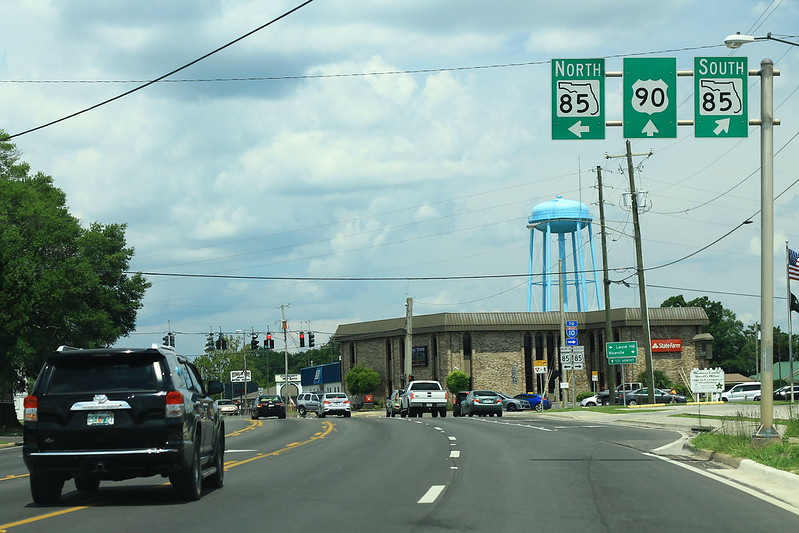- Home
- Florida History
- Florida Heritage Sites
- Florida Hurricane History
FLORIDA HURRICANE HISTORY
By Mike Miller Updated August 15, 2023
If you live in Florida for any length of time, you will probably either ride through a few major hurricanes or get the heck out of the way of one before it arrives.
Hurricanes - and their weaker cousin, the tropical cyclone - pose a significant threat to Florida, as the state's extensive coastline and geographic location make it particularly vulnerable to these devastating storms.
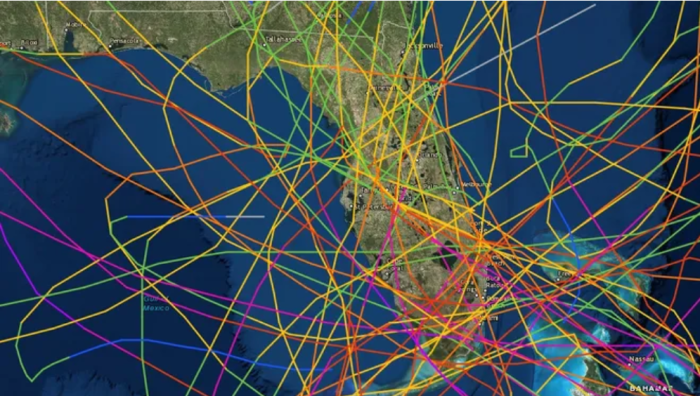 100 Years of Florida Hurricane Paths
100 Years of Florida Hurricane PathsNational Oceanic and Atmospheric Administration
The combination of powerful winds, torrential rainfall, and storm surges can lead to widespread destruction, uprooting trees, knocking down power lines, ripping roofs off homes, and causing massive flooding from heavy rains.
Hurricanes can also spawn tornadoes, adding another layer of danger to an already terrifying situation.
The chaos and destruction brought by hurricanes can leave communities in shambles, displacing residents and causing emotional turmoil for those who have lost their homes, belongings, and loved ones.
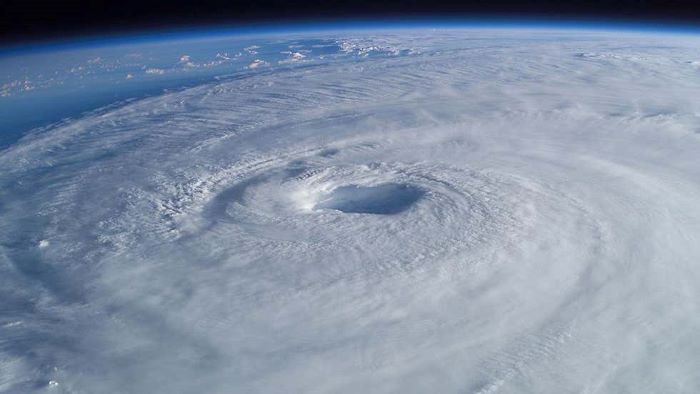 Hurricane Isabel Missed Florida
Hurricane Isabel Missed FloridaLandfall in NC Outer Banks
A hurricane warning or evacuation orders, if not heeded promptly, can leave people stranded in life-threatening situations. Key West and the other Florida Keys in Monroe County are quite often evacuated during potential hurricane threats.
In the midst of a hurricane, the deafening sound of strong winds, the relentless pounding of rain, and the darkness caused by power outages only heighten the terror experienced by those in the storm's path.
For many, the psychological impact of living through a hurricane can be long-lasting, with the mere mention of an approaching storm triggering memories of past traumas.
Many people who rode out Hurricane Andrew in Homestead suffered permanent hearing loss and now have such a fear of hurricanes they pack up and leave Florida if there is even a hint of a hurricane heading their way.
The typical Atlantic hurricane season runs from June 1 through November 30, but there have been some exceptions. We keep our eyes open for any tropical depression that develops in the Atlantic and hope it doesn't trigger a hurricane watch and impact our lives.
We have selected some of the most impactful hurricanes in Florida for our list.
22 MEMORABLE FLORIDA HURRICANES
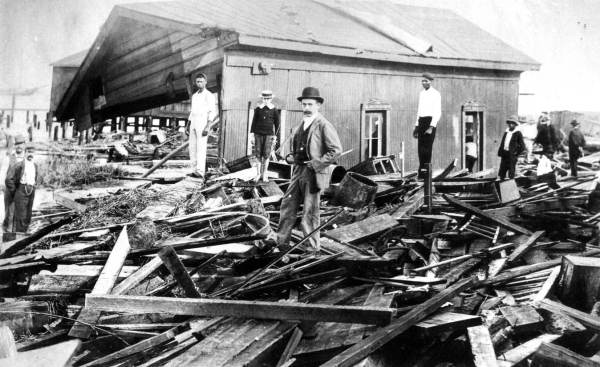 Damage from 1896 Hurricane, Fernandina Beach
Damage from 1896 Hurricane, Fernandina BeachFlorida Memory, State Archives of Florida
Cedar Keys Hurricane made landfall in the Cedar Keys on Florida's west coast on September 29, 1896 with a wind speed of 125 mph and a storm surge of 10.5 feet. It moved quickly over the state without losing much intensity and did extensive damage to homes and agriculture in North Florida and on the east coast.
Great Miami Hurricane made landfall in Miami on September 18, 1926, the. It was a Category 4 storm with wind speeds of 150 mph, storm surge of 10-15 feet, property damage of $105 million, and 372 lives lost.
The Okeechobee Hurricane hit West Palm Beach on September 17, 1928, as a Category 4 storm. It had sustained winds of 145 mph, storm surge of 6-9 feet, property damage of $25 million in South Florida, and between 2,500 to 3,000 lives were lost. The damage and death from this deadliest hurricane was due to the overflowing of Lake Okeechobee.
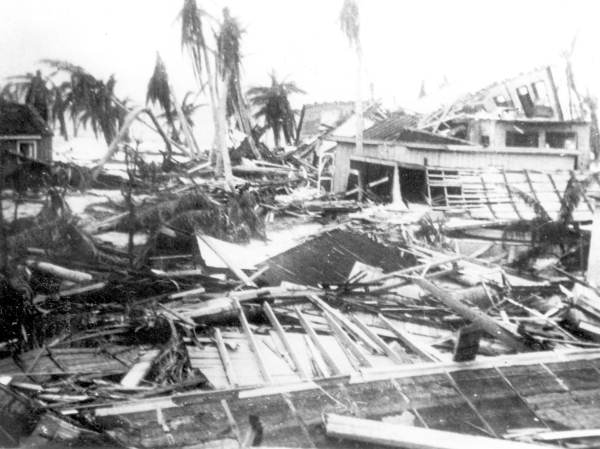 Long Key After the Labor Day Hurricane
Long Key After the Labor Day HurricaneThe Labor Day Hurricane struck Upper Matecumbe Key and other Florida Keys on September 3, 1935, as a Category 5 storm with wind speeds of 185 mph, storm surge of 18-20 feet, property damage of $6 million, and 408-600 lives lost. It is considered to be the strongest hurricane ever to hit Florida.
Hurricane Donna made landfall in Marathon on September 10, 1960, as a Category 4 storm with wind speeds of 145 mph, storm surge of 13 feet, property damage of $387 million, and 50 lives lost. It pounded Naples and swept across the state doing severe damage to areas along the Atlantic Ocean beaches.
Hurricane Cleo hit Miami on August 27, 1964, as a Category 2 storm with wind speeds of 110 mph, storm surge of 4-6 feet, property damage of $125 million, and 3 lives lost.
Hurricane Betsy struck Key Largo on September 8, 1965, as a Category 3 storm with wind speeds of 130 mph, storm surge of 6-10 feet, property damage of $1.42 billion, and 75 lives lost.
Hurricane Camille made landfall in Bay St. Louis, Mississippi, on August 17, 1969, as a Category 5 storm with wind speeds of 175 mph, storm surge of 24.6 feet, property damage of $1.42 billion, and 259 lives lost. Note that Hurricane Camille did not make landfall in Florida but still had significant impacts.
Hurricane Eloise made landfall in Bay County, Florida, on September 23, 1975, as a Category 3 storm with wind speeds of 125 mph, storm surge of 12-16 feet, property damage of $560 million, and 21 lives lost.
Hurricane David hit West Palm Beach on September 3, 1979, as a Category 1 storm with high winds of 80 mph, storm surge of 4-6 feet, property damage of $95 million, and 5 lives lost.
Hurricane Elena made landfall in Cedar Key on September 2, 1985, as a Category 3 storm with wind speeds of 125 mph, storm surge of 8-12 feet, property damage of $1.3 billion, and 9 lives lost.
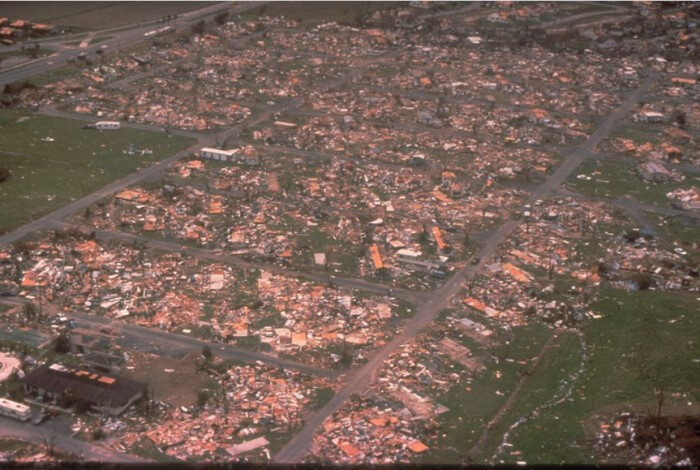 Homestead, Florida After Hurricane Andrew
Homestead, Florida After Hurricane AndrewHurricane Andrew made landfall in Homestead on August 24, 1992, as a Category 5 storm with wind speeds of 165 mph, property damage of $27 billion, and 65 lives lost.
Hurricane Opal hit Pensacola Beach, on October 4, 1995, as a Category 3 storm with wind speeds of 115 mph, storm surge of 10-15 feet, property damage of $4.7 billion, and 59 lives lost.
Hurricane Charley struck Cayo Costa on August 13, 2004, as a Category 4 storm with wind speeds of 150 mph, storm surge of 6-8 feet, property damage of $16 billion, much of it in Punta Gorda, and 15 lives lost.
Hurricane Frances made landfall in Sewall's Point in Stuart, on September 5, 2004, as a Category 2 storm with wind speeds of 105 mph, storm surge of 5-8 feet, property damage of $10 billion, and 7 lives lost.
Hurricane Ivan made landfall as a Category 3 hurricane close to Pensacola in Gulf Shores, Alabama on September 16, 2004 with winds of 130 mph. The storm did tremendous damage in the Caribbean with $26 billion in property damage including $20.5 billion in the US. 64 people were killed in the Caribbean and 25 in the United States, 14 of them in Florida.
Hurricane Jeanne hit Hutchinson Island, Florida, on September 26, 2004, as a Category 3 storm with wind speeds of 120 mph, storm surge of 5-7 feet, property damage of $7.5 billion, and 3,037 lives lost in Haiti, Puerto Rico including 5 in the US.
Many Floridians will never forget 2004. Four hurricanes kept the state in turmoil from August through September: Charley, Frances, Ivan, and Jeanne.
It was difficult to decide whether to run or stay during this confusing period. The National Hurricane Center of the National Weather Serice had its hands full keeping track of things.
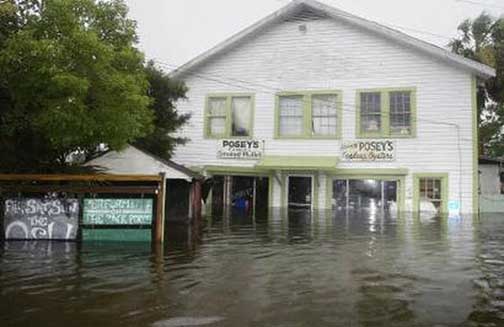 Posey's Oyster Bar, St. Marks, After Dennis
Posey's Oyster Bar, St. Marks, After DennisHurricane Dennis made landfall on Santa Rosa Island on the Florida Panhandle Gulf Coast on July 10, 2005, as a Category 3 storm with wind speeds of 120 mph, storm surge of 7-9 feet, severe damage of at $2.5 billion, and 15 lives lost.
Hurricane Wilma struck Cape Romano, Florida, on October 24, 2005, as a Category 3 storm with wind speeds of 120 mph, storm surge of 5-8 feet, property damage of $19 billion, and 5 lives lost.
Hurricane Irma hit Cudjoe Key, Florida, on September 10, 2017, as a Category 4 storm with wind speeds of 130 mph, storm surge of 5-10 feet, property damage of $50 billion, and 84 lives lost.
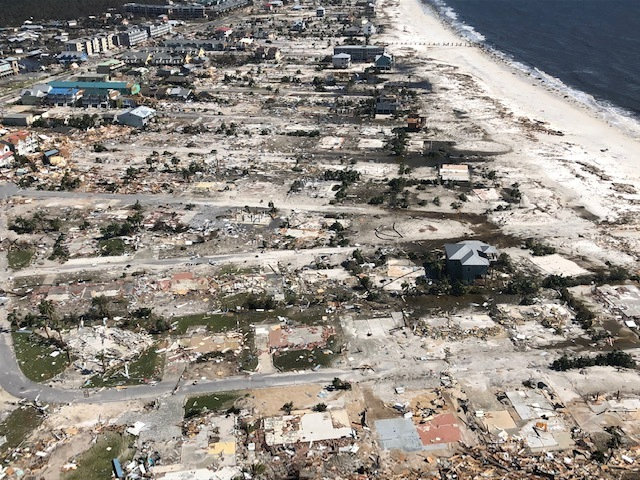 Mexico Beach After Hurricane Michael
Mexico Beach After Hurricane MichaelHurricane Michael made landfall in Mexico Beach, Florida, on October 10, 2018, as a Category 4 storm with wind speeds of 155 mph, storm surge of 9-14 feet, property damage of $25 billion, and 49 lives lost.
Hurricane Sally struck near Pensacola with its landfall in Gulf Shores, Alabama, on September 16, 2020, as a Category 2 storm with wind speeds of 105 mph, storm surge of 4-7 feet, property damage of $7.3 billion, and 8 lives lost. It had gathered strength before landfall because of its long path over the Gulf of Mexico.
This time lapse webcam shows the devastion from Hurricane Ian.
Hurricane Ian made landfall near Cayo Costa on September 28, 2022 as a Category 5 storm with wind speeds of 157 mph or more and a storm surge of 15 feet. It did extensive damage to Fort Myers Beach, Sanibel, and Captiva along with other Southwest Florida communties.
Hurricane Nicole made landfall near Vero Beach on November 10, 2022 as a Category 1 storm with maximum wind speeds of 75 mph and heavy rainfall. It caused severe beach erosion in Volusia, St. Johns, and Flagler counties. It caused 5 deaths in Florida.
This list constantly changes from year to year. Now, here's our list of 10 Florida cities safest from hurricanes
Our Facebook page has more than 130,800 followers who love off the beaten path Florida: towns, tourist attractions, maps, lodging, food, festivals, scenic road trips, day trips, history, culture, nostalgia, and more.
By Mike Miller, Copyright 2009-2025
Florida-Back-Roads-Travel.com
Florida Back Roads Travel is not affiliated with or endorsed by Backroads, a California-based tour operator which arranges and conducts travel programs throughout the world.
